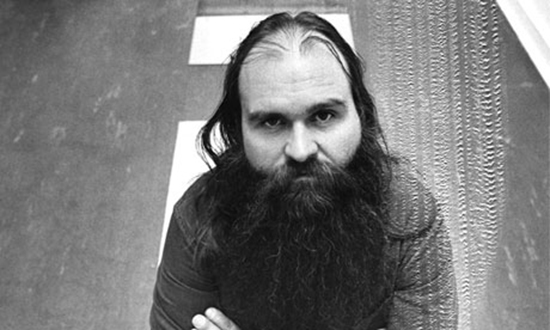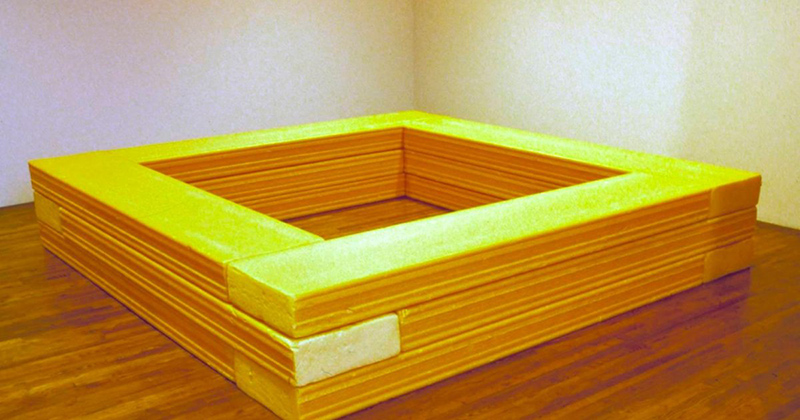TRACES: Carl Andre
 Today is the occasion to bear in mind Carl Andre (16/9/1935- ), who during the ‘60s and ‘70s, produced a number of sculptures which are now counted among the most innovative of his generation. His most significant contribution was to distance sculpture from processes of carving, modeling, or constructing, and to make works that simply involved sorting and placing. This column is a tribute to artists, living or dead, who have left their mark in Contemporary Art. Through documents or interviews, starting with: moments and memories, we reveal out from the past-unknown sides of big personalities, who left their indelible traces in time and history…
Today is the occasion to bear in mind Carl Andre (16/9/1935- ), who during the ‘60s and ‘70s, produced a number of sculptures which are now counted among the most innovative of his generation. His most significant contribution was to distance sculpture from processes of carving, modeling, or constructing, and to make works that simply involved sorting and placing. This column is a tribute to artists, living or dead, who have left their mark in Contemporary Art. Through documents or interviews, starting with: moments and memories, we reveal out from the past-unknown sides of big personalities, who left their indelible traces in time and history…
By Dimitris Lempesis
 Carl Andre was born in Quincy, Massachusetts. From 1951 to 1953, he attended the Phillips Academy, Andover, where he studied art under Patrick Morgan. After a brief enrollment in Kenyon College, Ohio, Andre earned enough money working at Boston Gear Works to travel to England and France in 1954. The following year, he joined United States Army Intelligence in North Carolina. In 1957 he settled in New York and worked as an editorial assistant for a publishing house. Shortly thereafter, he began executing wood sculptures influenced by Constantin Brancusi and by the black paintings of his friend Frank Stella. He was a leading member of the Minimalist movement, which coalesced during the early to mid-1960s. In addition to making sculpture, he also began to write poems in the tradition of Concrete Poetry, displaying the words on the page as if they were drawings. From 1960 to 1964, he was a freight brakeman and conductor for the Pennsylvania Railroad in New Jersey. Andre’s first solo show was held in 1965 at the Tibor de Nagy Gallery, New York. Since the mid ‘60s the underlying premises of Andre’s art have remained practically unchanged, inasmuch as the procedure for making the work has not altered. This has meant that his work tends to display a range of distinct characteristics which make it instantly recognizable. For instance, much of his mature sculpture is extremely low-lying, undermining all traditional associations about sculpture’s relation to the upright human body. In 1969 Andre became closely associated with the New York-based Art Workers’ Coalition. The group lobbied the city’s major public galleries for increased artists’ rights and an end to sexism, racism and oppression within the art world. It was arguably during this period that Andre’s eminence among fellow artists and North American and Western European art institutions was at its highest. In the ‘70s, the artist prepared numerous large-scale installations, such as Blocks and Stones in 1973 for the Portland Center for the Visual Arts, Oregon, and outdoor works, such as Stone Field Sculpture in 1977 in Hartford. In 1985 his artistic reputation was severely damaged by a tragic event in his personal life. His then wife, Ana Mendieta, fell to her death from their New York apartment window. Andre was arrested for her murder, and, although he was fully acquitted in 1988, he became a hate figure for those who were close to Mendieta. In their eyes he came to personify many of the oppressive, establishment values against which he and the Art Workers’ Coalition had campaigned in the late ‘60s. He continues to emphasize material and spatial specificity.
Carl Andre was born in Quincy, Massachusetts. From 1951 to 1953, he attended the Phillips Academy, Andover, where he studied art under Patrick Morgan. After a brief enrollment in Kenyon College, Ohio, Andre earned enough money working at Boston Gear Works to travel to England and France in 1954. The following year, he joined United States Army Intelligence in North Carolina. In 1957 he settled in New York and worked as an editorial assistant for a publishing house. Shortly thereafter, he began executing wood sculptures influenced by Constantin Brancusi and by the black paintings of his friend Frank Stella. He was a leading member of the Minimalist movement, which coalesced during the early to mid-1960s. In addition to making sculpture, he also began to write poems in the tradition of Concrete Poetry, displaying the words on the page as if they were drawings. From 1960 to 1964, he was a freight brakeman and conductor for the Pennsylvania Railroad in New Jersey. Andre’s first solo show was held in 1965 at the Tibor de Nagy Gallery, New York. Since the mid ‘60s the underlying premises of Andre’s art have remained practically unchanged, inasmuch as the procedure for making the work has not altered. This has meant that his work tends to display a range of distinct characteristics which make it instantly recognizable. For instance, much of his mature sculpture is extremely low-lying, undermining all traditional associations about sculpture’s relation to the upright human body. In 1969 Andre became closely associated with the New York-based Art Workers’ Coalition. The group lobbied the city’s major public galleries for increased artists’ rights and an end to sexism, racism and oppression within the art world. It was arguably during this period that Andre’s eminence among fellow artists and North American and Western European art institutions was at its highest. In the ‘70s, the artist prepared numerous large-scale installations, such as Blocks and Stones in 1973 for the Portland Center for the Visual Arts, Oregon, and outdoor works, such as Stone Field Sculpture in 1977 in Hartford. In 1985 his artistic reputation was severely damaged by a tragic event in his personal life. His then wife, Ana Mendieta, fell to her death from their New York apartment window. Andre was arrested for her murder, and, although he was fully acquitted in 1988, he became a hate figure for those who were close to Mendieta. In their eyes he came to personify many of the oppressive, establishment values against which he and the Art Workers’ Coalition had campaigned in the late ‘60s. He continues to emphasize material and spatial specificity.












